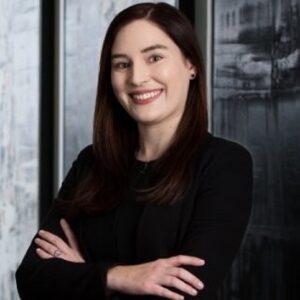
WS: Would you tell us about your background, your interest in the American West and Western Art, and how you first became involved with Western Spirit?
Ferrigni: I wasn’t born in Arizona but I’ve called this state home since a very young age, so I consider myself an Arizona native. I grew up in the Phoenix metropolitan area and my parents, took me and my sister to the museums in the area: the Heard, Pueblo Grande, the Phoenix Art to name a few, so that’s where my interest in and love for the art and history of the West began. I did my undergraduate work at U of A—Tucson and graduated from the Sandra Day O’Connor College of Law in 2015 and worked as a policy officer at the Arizona Corporation Commission and then as an attorney with Fennemore Craig’s Environmental and Natural Resources practice group. I am now a Senior Attorney at Arizona Public Service Company. Land, energy, and natural resources are something I deal with on a daily basis. How I learned about Western Spirit is kind of funny. I was walking around Old Town Scottsdale with my family four or five years ago and we didn’t know anything about the museum but we saw it and thought, “Wow, this is such a cool building!” We peeked inside and were pleasantly surprised that it was a Western art museum. And we went in. I was floored by the caliber of the artists and have been coming back routinely with my family ever since. I’ve attended Saddle Up for the past few years and got to know some of the Board Members who invited me to join, and I am very appreciative of the opportunity to serve on the Board.
WS: What do you think you might bring to the Board and to the museum?
Ferrigni: I believe that I am one of the youngest Board Members in the museum’s history so I hope to offer a fresh, unique perspective. One of the things I’m passionate about is coming up with creative ways to target more families and younger folks and get them to visit and take in all the wonderful art at Western Spirit. I think it’s going to take a mix of events we host—corporate events, weddings, and so on. People who attend events will stroll around and have something to eat and drink. The event becomes an experience, and once they see the amazing artworks and objects they’ll keep coming back. The experience gets them in the door. Next, we have to consider the impact that an expansion of our social media presence could have on attracting visitors. Young people get their news, announcements of events—like new restaurants and art openings—by scrolling and stumbling across posts on social media. It’s another way to get the word out and potentially attract new visitors. You can’t be afraid to try new ideas. You can’t know what will bring people in until you try. I should add that everyone on the Board has been very open and I’m extremely optimistic.
WS: What are some of the objects and exhibitions at Western Spirit that excite you?
Ferrigni: I love it all. Now that I’m on the Board, I’m excited to learn more about Western Art. I really like Frederic Remington, especially the bronzes. And I’m kind of a photography buff. Seeing the Edward Curtis exhibition, I was floored by something I had never seen in a museum before, a journey that described who the artist was, what his thinking and process was. You get into the adventure of Curtis’s life and the journey becomes the kind of experience that I believe will interest younger people. I also love the John Coleman bronzes. My father always had an appreciation for his work and I inherited that. And the George Catlin prints upstairs—when I look at them, they transport me back in time to the Plains.
WS: How do you think Western Spirit can raise its profile in the community?
Ferrigni: I don’t want Western Spirit to be a best-kept secret. I talk to people who have been here in the Valley even longer than I have and they say, “Western Spirit? What’s that?” So one of my goals is to change that, starting with people my own circle. To people I meet who have never visited, I relate my own experience. First, I explain that it’s fun just to explore the building—which is a work of art itself, and a model of sustainability. Then, I tell them that while I eagerly anticipate the new exhibitions I also love coming back again and again to see my favorites.
But everyone I have brought to the museum has walked away with the same kind of awe I felt—and still feel.
WS: Any last thoughts?
Ferrigni: Growing up in Arizona, visiting our local monuments and museums gave me a real appreciation for the history of the West and I go back to movies and series, like Centennial, that show the sweep of generations and the dichotomy of development and preservation. The story of the West is great story, one that makes me proud to call Arizona home.
